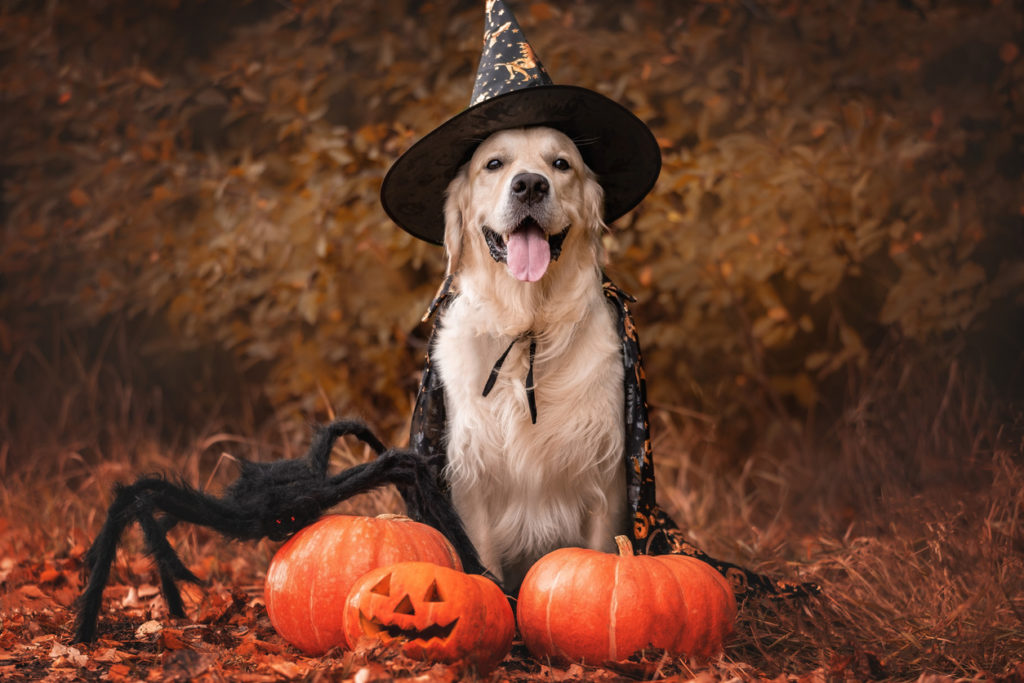Do You Know How to Keep Fluffy and Fido Safe This Halloween?

Halloween Pet Trick or Treat
As Halloween approaches, so does frightening family fun such as bobbing for apples, dressing up, harmless pranks, haunted houses and of course trick-or-treating.
Even with all the light-hearted festivities that mark the favorite pastime, keep safety in mind for every member of the family, pets included. The hallowed eve of candy and costumes and ghosts and goblins can pose potential hazards for cats and dogs. With Fluffy and Fido already experiencing higher stress levels because of the hustle and bustle of holiday, the potential hazards can lead to more serious harm if they are not recognized and mitigated.
“A dog’s natural instinct is to protect their home or to alert you that a stranger has arrived,” Amy Nichols, of the Humane Society of the United States, said in a blog. “And cats typically prefer a quiet environment with their family. Trick-or-treaters continually knocking on the door or ringing the bell can be very stressful to both dogs and cats.”
Cats and dogs should remain indoors during Halloween for many reasons. Cats, especially black ones, are targeted due to their symbolism and harassed. Worse, they are captured. Also, black cats and black dogs are difficult to see at night.
“There will be more people out than normal after dark, and dark or black pets can be especially at risk of being run over,” according to a PetHub article. “What’s even more scary is that a significant number of black cats disappear every year on Halloween – due to some not so nice people.”
Regarding candy and costumes, both have risks for pets. Keep pets away from candy. Chocolate can be deadly to cats and dogs as can low-calorie sweeteners found in sugar-free candy. A best practice is to feed pets earlier in the evening so they are less likely to beg or steal. Costumes, although cute, might be dangerous for pets. Outfitting four-legged friends in capes, hats, masks and other garb might cause limited movement, sight and ability to breathe.
“The ASPCA recommends that you don’t put your dog or cat in a costume unless you know he or she loves it,” the American Society for the Prevention of Cruelty to Animals Web site states. “Ill-fitting outfits can get twisted on external objects or your pet, leading to injury.”
Flame-lit jack-o-lanterns, dripping candles and other Halloween votives should not be accessible to pets. Not only could an animal get burned by the single swipe of a paw, a fire could break out. Pumpkins, if ingested by pets, will cause stomach problems if the gourd is not fresh and has acquired mold.
“Gastrointestinal upset is a possibility whenever pets eat something they aren’t used to, and intestinal blockage can occur if large pieces are swallowed,” according to PetMD. “So, keep the pumpkins and corn stalks away from your pets.”
Here are a few more tips.
- Be mindful of glow sticks so they are not nibbled on and ingested. “While glow sticks can help keep people safe on Halloween night, they can add some unwanted drama to the holiday if a pet chews one open,” according to PetMD. “Pets who get into a glow stick may drool, paw at their mouth, become agitated, and sometimes even vomit.”
- Make sure pets are wearing identification tags and consider having them microchipped. “If your dog or cat should escape and become lost, having the proper identification will increase the chances that he or she will be returned,” according to PetMD. “Collars and tags are ideal if a Good Samaritan is able to collect your wayward pet, but microchips offer permanent identification should the collar or tag fall off. Just make sure the information is up-to-date. Use Halloween as a yearly reminder to double check your address and phone number on tags and with the company who supports pet microchips.”
Here are suggestions for ensuring Halloween is spirited and spooky for humans and easy and breezy for pets.
- Minimize doorbell noise by setting up a table and chairs outside to greet trick-or-treaters.
- If having friends over for a party, prepare a secluded room for pets and place a do-not-enter sign on the door.
“Halloween can be lots of fun,” concludes the Veterinary Centers of America. “It may be your favorite holiday! So go ahead. Buy the candy. Plan the costume. Map out your Trick or Treat route. Decorate the house. Just keep your dog in mind as you prepare for Halloween so that the entire family has a good, safe time.”
That goes for cats, too. Happy Halloween!
Share This


